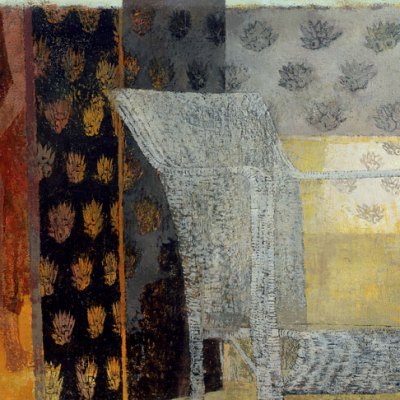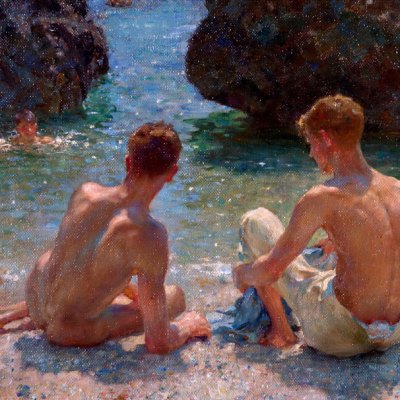 Posing the unlikely question ‘are socialites’ sitting rooms interesting?’, Jane Stevenson sets out to realign 20th-century visual and literary culture in England, joining other studies that complicate our understanding of modernism and modernity. Christopher Reed’s Bloomsbury Rooms identified a subversive ‘domestic modernism’ in the early 20th century. Peter Wollen’s Raiding the Icebox analysed a decorative modernism in Paris around 1910, exemplified by the textiles of Paul Poiret and by the Gesamtkunstwerk that was the Ballets Russes, setting them against histories dominated by analytical cubism. Alexandra Harris’s brilliant Romantic Moderns charted another counter-movement, a ‘passionate, exuberant return to tradition’ among a loosely linked group of British writers and artists just before and during the Second World War. Harris saw a response to modernity in the archaism of aesthetes in fancy dress, characterising Cecil Beaton and his friends as ‘silver-suited futurists’ who also aspired to be 18th-century squires.
Posing the unlikely question ‘are socialites’ sitting rooms interesting?’, Jane Stevenson sets out to realign 20th-century visual and literary culture in England, joining other studies that complicate our understanding of modernism and modernity. Christopher Reed’s Bloomsbury Rooms identified a subversive ‘domestic modernism’ in the early 20th century. Peter Wollen’s Raiding the Icebox analysed a decorative modernism in Paris around 1910, exemplified by the textiles of Paul Poiret and by the Gesamtkunstwerk that was the Ballets Russes, setting them against histories dominated by analytical cubism. Alexandra Harris’s brilliant Romantic Moderns charted another counter-movement, a ‘passionate, exuberant return to tradition’ among a loosely linked group of British writers and artists just before and during the Second World War. Harris saw a response to modernity in the archaism of aesthetes in fancy dress, characterising Cecil Beaton and his friends as ‘silver-suited futurists’ who also aspired to be 18th-century squires.
Jane Stevenson shares Harris’s evident dislike of the modern movement as a socio-political force and in Baroque Between the Wars white, straight, mostly male modernists, wedded to functional design and architecture, are contrasted with individuals whose activities represent what Stevenson calls ‘modern baroque’. Mostly queer, often female, they embraced a coded aesthetic that was equivocal and unashamedly decorative. We are left in no doubt as to where Stevenson’s sympathies lie when she argues that this modern baroque sensibility was more democratic in spirit and, even, accessibly close to working-class vernacular. Stevenson rightly observes that avant-garde paintings did not readily sell. Fine artists were often forced to turn to the worlds of design, interior decoration and fashion, activities which, she argues correctly, have been ‘airbrushed out of the history of art’.
As Cecil Beaton’s career suggests, the progenitors of Stevenson’s modern baroque were largely apolitical and necessarily upwardly mobile. In a period that lacked state funding for the arts, artistically minded upper-class figures like the Sitwell brothers (and their less financially favoured but well-connected sister) formed taste. Stevenson acutely analyses the social adaptation required of young, mainly queer, artistic men who sought to make social connections that would fund and disseminate their work. Accents were honed and the tripwires of aristocratic nomenclature were mastered by figures as diverse as Frederick Ashton, John Betjeman, Noël Coward, Anthony Tudor, William Walton, Rex Whistler and, of course, Beaton.
Gifted gay women faced even greater challenges. Lesbianism sought social invisibility outside a series of closed female circles but Stevenson effectively delineates a subtle Sapphic aesthetic, drawn to Surrealism, mixing the outré with the respectable. In fact inter-war women tended to sidestep Stevenson’s modernism-modern baroque binary entirely. For instance, Dorothy Todd, the gay editor of British Vogue, and her fashion editor and partner Madge Garland, publicised undoubted modernists from Le Corbusier and Gropius to the rug designer Marion Dorn but they also alerted readers to Dada, to Jean Cocteau and to Josephine Baker. And Stevenson does not quite position a whole world of gay craftswomen – the austerely beautiful work of the textile artists Elizabeth Peacock, Phyllis Barron and Dorothy Larcher, and the potter Katherine Pleydell-Bouverie surely belongs in the modernist camp.
At times Stevenson sets up a straw-man version of functionalist modernism for attack – as in her chapter on architecture, ‘Machines to Live In’. Her belief that women ‘failed to embrace a modernist aesthetic’ overlooks architects such as Elisabeth Benjamin, Jane Drew and Elizabeth Denby and the surprising number of women clients of modernist architects in Britain – figures like Dr Edith Summerskill, the sculptor Dora Gordine and Mrs Mash, the director of the Good Housekeeping Institute, who commissioned Ernst Freud to design – full disclosure here – the beautiful house in which I grew up.
Baroque Between the Wars draws its strength from Stevenson’s omnivorous sourcing of material and her intellectual curiosity. But if ‘modern baroque’ has traction for a broad range of inter-war visual and performing arts, it works less well, as Stevenson acknowledges, in the context of literature. Where, for instance, do we situate James Joyce? An undoubted modernist, Joyce proves impossible to categorise, his rich intertextuality having little in common with, say, architectural modernism’s quest for purity and new beginnings. And at times Stevenson appears to abandon her quest for a modern baroque altogether, digressing on French crime fiction by contrast with Agatha Christie, or interwar fantasy writing ranged loosely round the undoubted baroque of Ronald Firbank, discussions that seem to belong in another equally fascinating book.
The view into the Painted Room at Port Lympne, Kent, with murals by Rex Whistler, photographed in 1933. Photo: Arthur Gill; © Country Life Picture Library

The last part of Baroque Between the Wars is discursively informative. The fantastical interwar gardens at Ditchley Park, Garsington and Port Lympne lead on to a brief disquisition on fashionable white interiors, which in their variousness of hue were the antithesis of Le Corbusier’s ‘Law of Ripolin’ (the architect argued for all buildings to be painted brilliant white). Glass is also examined. If modernists preached transparency, exponents of modern baroque were drawn to the ambiguities and false perspectives of reflective surface. A section on tastes in church furnishing takes in the Counter-Reformation confections of Martin Travers, the faux-simple interior of Conrad Noel’s church at Thaxted, Essex and the intriguing purchases made by the Jesuit priest Father D’Arcy.
The complex status of murals and of a gifted artist like Rex Whistler, compared by George Bernard Shaw to a housepainter, suggest a further recalibration of the artistic canon. A final re-ordering of hierarchies is achieved triumphantly in chapters on the ‘Uncanonical Arts’, which take in the aesthetics of society photography, fashion and couture, the collecting, making and wearing of masks, flower arranging, ballet, and the sensual science of scent creation. Here, as befits her subject matter, Stevenson’s writing becomes boldly irreverent and playful, in harmony with the stylish, evanescent world that Baroque Between the Wars seeks to recuperate.
Baroque Between the Wars: Alternative Style in the Arts, 1918–1939 by Jane Stevenson is published by Oxford University Press.
From the June 2018 issue of Apollo. Preview and subscribe here.



